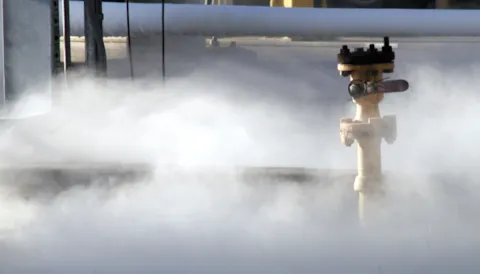Piping vibrations
Avoiding the resultant cost of vibration on process pipework
Piping vibrations
Vibration of process plant piping can be a significant risk to asset integrity and safety. This is often due to flow induced vibration (FIV) and acoustic induced vibration (AIV), and is related to the flow of the main process fluid through the piping system.
Other possible sources of piping vibration include:
- Mechanical vibration and pulsations from compressors and pumps;
- Flow induced pressure pulsations related to the pipework configuration and other components and features in the flow;
- Valve configuration and operation;
- Cavitation and flashing across valves in liquid service.
DNV has extensive experience in the successful development and implementation of predictive tools and strategies for addressing these issues for offshore and onshore operators in the UK and internationally.
Flow induced vibration
Flow induced vibration is the result of turbulence in the process fluid, which occurs due to major flow discontinuities such as bends, tees, partially closed valves, and small bore connections. The high levels of broadband kinetic energy created downstream of these sources is concentrated at low frequencies, generally less than 100 Hz, and can lead to excitation of vibration modes of the piping and connected equipment. The extent of this problem depends on the piping design, support configuration and stiffness, valve operation, and other related factors which determine the severity of the resulting vibration.
Management of the risks related to FIV can be tackled through screening activities to pinpoint piping sections of concern, vibration monitoring and investigation of identified problems, and development of targeted modifications to operational parameters, the pipework configuration, and supports.
Acoustic induced vibration
A relief or control valve on piping systems in gas service, or other pressure reducing devices, can generate high levels of high frequency acoustic energy, an effect commonly referred to as acoustic induced vibration. In addition to high noise levels arising external to the piping, this excitation can result in high frequency vibration of the pipe wall, with the potential for high dynamic stresses at welded features such as supports and small bore connections. This in turn can lead to the possibility of fatigue cracking within a relatively short period of time (minutes or hours).
Assessment of the risks related to AIV can be carried out for pressure reducing devices on gas systems, such as control valves, pressure relief valves, and blowdown valves, to screen for this failure mechanism, through prediction of the acoustic noise generated downstream, and estimation of the risk of failure of the piping. Detailed investigation and the development of solutions would then be conducted for any sections considered to be at high risk.
Flow induced pulsation
Flow induced pulsation (FIP) can be caused by dead leg branches in pipework, which can be excited as acoustic resonances with discrete frequencies. These resonances can induce large shaking forces in the pipework, leading to integrity and safety risks.
Pulsation analysis to industry design criteria is highly recommended for both design and engineering of complex pipework and manifolds (e.g. compressor stations), and to assess the operation of existing gas plants, and DNV has developed specific tools to perform this type of analysis. Mitigation actions can therefore be focused on curing the source of the pulsation and vibration instead of limiting the effects.
Vibration measurement and analysis services
DNV offers a range of vibration measurement and analysis services to determine and manage the risk of vibration-induced fatigue failure due to piping vibration, with specialist skills and knowledge in the following areas:
- Failure investigation
- Development and implementation of piping vibration screening strategies
- Piping vibration and pulsation monitoring on operational assets
- Fatigue analysis
- Dynamic finite element modelling
- Identification and development of optimum solutions
- Design guidance
- AIV, FIV and FIP analysis for process piping, including relief and blowdown systems
- Pulsation and gas acoustics modelling, including root cause analysis and mitigation.
Benefits
Our service enables successful and cost effective management of pipiework vibration risks, and is supported by a wealth of experience in the oil and gas industry across the company, with benefits including:
- Improved piping integrity
- Improved safety
- Reduced occurrence of hydrocarbon release incidents
- Improved asset reliability and availability
- Compliance with contractual obligations
- Compliance with industry best practice guidelines and pressure systems legislation
- Improved design criteria for new installations
- Significant reduction in shut-down and maintenance costs
- Validated operation of existing plant and installations beyond current operational conditions.
Related information
Integrity management and life extension of ageing assets
Download brochure




